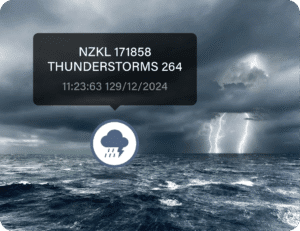Ocean navigation has always presented challenges. However, the increasing frequency and intensity of extreme weather, as seen in the recent events in the Mediterranean, highlight the need for a new level of proactive safety measures. AI-powered systems, such as PredictWind’s new Extreme Weather Alerts, are revolutionizing how mariners access and utilize critical weather data, empowering them to make more informed and timely decisions and take preventative action.

The Problem: The Challenge of Timely Information
For decades, the Global Maritime Distress and Safety System (GMDSS) has been fundamental to maritime safety, providing crucial weather warnings and distress alerts. However, GMDSS forecasts are often delivered as lengthy text reports, requiring mariners to manually sift through dense information to identify immediate threats. This process can be time-consuming and challenging, especially in rapidly changing conditions or when navigating unfamiliar waters, where delays can have consequences.

AI as a Solution: A Paradigm Shift in Alert Systems
The development of AI-powered systems represents a significant shift in how mariners receive critical weather information. PredictWind’s new Extreme Weather Alerts feature showcases this shift by employing AI algorithms to automatically analyze GMDSS text forecasts and extract the most urgent warnings. A world-first, this technology pinpoints critical details about extreme weather events and delivers them as instant mobile notifications, eliminating the need for manual review.
“These real-time alerts represent a significant leap forward in maritime safety,” says Jon Bilger, PredictWind Founder. “By harnessing the power of AI, we’re transforming complex weather data into actionable intelligence, equipping sailors with the data they need to navigate safely and take action before dangerous conditions strike.”
The Impact of Enhanced Alerts
The ability to receive instant, AI-driven alerts has the potential to dramatically improve safety outcomes. By providing clear and concise summaries of threats, alongside access to the full GMDSS forecast, these systems empower mariners to make faster, more informed decisions. This is especially crucial in situations where seconds can mean the difference between safety and disaster.

Beyond Weather Alerts
PredictWind’s AI capabilities extend to their AI Polars feature, which uses machine learning to create optimized boat performance models based on real-time data from the PredictWind DataHub. This results in more accurate weather routing by factoring in wave conditions.
The Future of Maritime Safety
As AI technology continues to advance, its role in maritime safety is set to expand significantly. From automated extreme weather analysis and real-time alerts to AI-driven navigation and collision avoidance systems, the potential for these technologies to reduce risk and enhance safety at sea is substantial. However, the ongoing need for human expertise and sound judgment remains crucial, ensuring that technology serves as a tool to aid, not replace, the mariner’s skill and experience.








